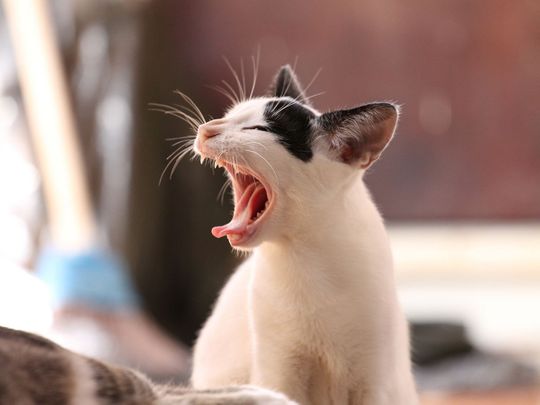
I first saw it in bits — two paws here, the tip of a tail there — on grainy, black-and-white images taken by our backyard trail camera. Normally that device captures only the wild animals you’d expect to find in a first-ring suburb: opossums, mainly, but also rabbits and raccoons and rat snakes, sometimes an owl, now and then a fox.
My heart lifted when I first saw a clearly feline haunch in one of the pictures, but the scale was all wrong for a bobcat. It was just an ordinary house cat, prowling in my backyard.
Soon the cat was showing up in the daytime, too, apparently drawn by the leftover bits of lunches left around the construction site two doors down from our house. He was a ragged, battle-scarred tom, thin but not emaciated, with one eye that didn’t open all the way. A feral cat, not someone’s cherished pet.
As we passed my husband’s car in the driveway one morning, my skittish rescue dog darted away from the tires, spooked by something under the car. I squatted down for a look. The feral cat hissed at me.
I did not know what to do, and I couldn’t tell her that the true miracle would not have been the saving of a doomed cat’s life. I couldn’t tell her that the true miracle will never come until human beings have finally learnt to live a better way: in concert with the natural world, and not in domination
Let me just say it, flat out: If I owned a gun, I swear I would have shot that cat. I would have chased that hissing cat out from under the car without a thought and shot it as it fled.
I wish you could see all the baby birds in our yard. Baby towhees and robins, baby redbirds and bluebirds. Two broods of house finches and two broods of house wrens. One morning, an ungainly fledgling crow sat nearby and rustled its feathers, yelling for food like a giant nestling.
A fuzzy screech owl chick spent an entire day staring wide-eyed at me from a tree near our back deck while its mother dozed beside it.
Cats are domestic animals that don’t belong outdoors. In the natural world, including my own backyard, animals kill one another every day, but there is ample scientific evidence that predation by cats is not part of any natural order.
The morning after I didn’t kill the feral cat, a child from the neighbourhood came to get me, hoping I could help a sick cat she’d found in her family’s driveway.
A few weeks earlier, this child had taken an infant deer mouse out of her dog’s mouth, and I had kept it alive overnight, long enough to drive it safely to Walden’s Puddle, a wildlife rescue organisation.
There it would be raised with other baby mice and then set free to fulfil its own role in the natural cycle of things. My young friend was hoping for another miracle.
No second miracle
There would be no second miracle. When we got to her house, the embattled tomcat was lying in the driveway, his limbs twitching, his eyes unseeing, his hindquarters resting in a pool of urine. From time to time his neck would arch, and his mouth would pull back in a grimace.
Our feral cat was in agony. Our feral cat was dying, and his suffering broke my heart.
Later, when Animal Control picked up his body, we learnt that the cat had been poisoned. Most likely a neighbour had set out rat poison, and the cat had caught and eaten the dying rodent.
Cats are killers, but they are not apex predators. In this neighbourhood, there are coyotes, great horned owls, at least one camera-shy bobcat.
Any one of them could handily kill a cat, but our feral cat didn’t lose his life to a hungry owl or coyote or bobcat. He died because a human being was too squeamish to set the kind of trap that leaves behind a corpse.
There are mousetraps that kill quickly and painlessly, and those traps don’t weaponize the mouse, turning it into a poison-delivery system for predators, but such traps do require people to face what they are doing: taking the life of another creature.
For weeks I have been trying to understand my own tears in the presence of a dying cat I did not love. It’s hard not to feel connected to a living thing in a state of suffering.
The tomcat's terrible death
In the weeks since the tomcat’s terrible death, I have thought a lot about the danger outdoor cats pose to the natural world and also about the danger the natural world poses to cats.
Most of all I have been thinking about the way human beings, the deadliest predators of all, keep finding new ways to destroy everything that sustains the planet that sustains us.
A hungry animal cannot be faulted for killing to eat. A feral cat — like a house cat allowed to roam outdoors — is not an evil creature. Like the poisoned mouse and the poisoned insects and all the other animals crowded out by development, it is simply a creature that has been failed by human beings.
My young neighbour came to me for help. At 10, she was sure that someone my age would know what to do about a dying cat.
I did not know what to do, and I couldn’t tell her that the true miracle would not have been the saving of a doomed cat’s life. I couldn’t tell her that the true miracle will never come until human beings have finally learnt to live a better way: in concert with the natural world, and not in domination.
Margaret Renkl is a contributing opinion writer for The New York Times who covers flora, fauna, politics and culture in the American South. She is the author of the book “Late Migrations: A Natural History of Love and Loss.”
— New York Times News Service







